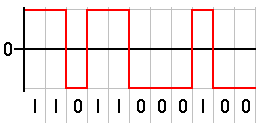|
Alternate-Phase Return-to-Zero
Alternate-Phase Return-to-Zero (APRZ) is an optical line code. In APRZ the field intensity drops to zero between consecutive bits, and the field phase alternates between neighbouring bits, so that if the phase of the signal is, for example, 0 in even bits (bit number 2''n''), the phase in odd bit slots (bit number 2''n''+1) will be ''ΔΦ'', the phase alternation amplitude. Special cases Return-to-zero can be seen as a special case of APRZ in which ''ΔΦ''=0, while Carrier-Suppressed Return-to-Zero (CSRZ) can be viewed as a special case of APRZ in which ''ΔΦ''=π (and the duty cycle is 67%, at least in the standard form of CSRZ). APRZ can be used to generate specific optical modulation formats, for example, APRZ-OOK, in which data is coded on the intensity of the signal using a binary scheme (light on=1, light off=0). APRZ is often used to designate APRZ-OOK. Characteristics The characteristic properties of an APRZ signal are those to have a spectrum similar to that of an RZ ... [...More Info...] [...Related Items...] OR: [Wikipedia] [Google] [Baidu] |
Line Code
In telecommunications, a line code is a pattern of voltage, current, or photons used to represent digital data transmission (telecommunications), transmitted down a communication channel or written to a storage medium. This repertoire of signals is usually called a constrained code in data storage systems. Some signals are more prone to error than others as the physics of the communication channel or storage medium constrains the repertoire of signals that can be used reliably. Common line encodings are Unipolar encoding, unipolar, Polar encoding, polar, Bipolar encoding, bipolar, and Manchester code. Transmission and storage After line coding, the signal is put through a physical communication channel, either a transmission medium or data storage medium.Karl Paulsen"Coding for Magnetic Storage Mediums".2007. The most common physical channels are: * the line-coded signal can directly be put on a transmission line, in the form of variations of the voltage or current (often us ... [...More Info...] [...Related Items...] OR: [Wikipedia] [Google] [Baidu] |
Field Intensity
In physics, field strength refers to a value in a vector-valued field (e.g., in volts per meter, V/m, for an electric field ''E''). For example, an electromagnetic field has both electric field strength and magnetic field strength. Field strength is a common term referring to a ''vector'' quantity. However, the word 'strength' may lead to confusion as it might be referring only to the magnitude of that vector. For both gravitational field strength and for electric field strength, The Institute of Physics glossary states "this glossary avoids that term because it might be confused with the magnitude of the ravitational or electricfield". As an application, in radio frequency telecommunications, the signal strength excites a receiving antenna and thereby induces a voltage at a specific frequency and polarization in order to provide an input signal to a radio receiver. Field strength meters are used for such applications as cellular, broadcasting, wi-fi and a wide variety of othe ... [...More Info...] [...Related Items...] OR: [Wikipedia] [Google] [Baidu] |
Field (physics)
In science, a field is a physical quantity, represented by a scalar (mathematics), scalar, vector (mathematics and physics), vector, or tensor, that has a value for each Point (geometry), point in Spacetime, space and time. An example of a scalar field is a weather map, with the surface temperature described by assigning a real number, number to each point on the map. A surface wind map, assigning an arrow to each point on a map that describes the wind velocity, speed and direction at that point, is an example of a vector field, i.e. a 1-dimensional (rank-1) tensor field. Field theories, mathematical descriptions of how field values change in space and time, are ubiquitous in physics. For instance, the electric field is another rank-1 tensor field, while electrodynamics can be formulated in terms of Mathematical descriptions of the electromagnetic field, two interacting vector fields at each point in spacetime, or as a Covariant formulation of classical electromagnetism, single-ra ... [...More Info...] [...Related Items...] OR: [Wikipedia] [Google] [Baidu] |
Phase (waves)
In physics and mathematics, the phase (symbol φ or ϕ) of a wave or other periodic function F of some real variable t (such as time) is an angle-like quantity representing the fraction of the cycle covered up to t. It is expressed in such a scale that it varies by one full turn as the variable t goes through each period (and F(t) goes through each complete cycle). It may be measured in any angular unit such as degrees or radians, thus increasing by 360° or 2\pi as the variable t completes a full period. This convention is especially appropriate for a sinusoidal function, since its value at any argument t then can be expressed as \varphi(t), the sine of the phase, multiplied by some factor (the amplitude of the sinusoid). (The cosine may be used instead of sine, depending on where one considers each period to start.) Usually, whole turns are ignored when expressing the phase; so that \varphi(t) is also a periodic function, with the same period as F, that repeatedly ... [...More Info...] [...Related Items...] OR: [Wikipedia] [Google] [Baidu] |
Return-to-zero
Return-to-zero (RZ or RTZ) describes a line code used in telecommunications signals in which the signal drops (returns) to zero between pulses. This takes place even if a number of consecutive 0s or 1s occur in the signal. The signal is self-clocking. This means that a separate clock does not need to be sent alongside the signal, but suffers from using twice the bandwidth to achieve the same data-rate as compared to non-return-to-zero format. The "zero" between each bit is a neutral or rest condition, such as a zero amplitude in pulse-amplitude modulation (PAM), zero phase shift in phase-shift keying (PSK), or mid-frequency in frequency-shift keying (FSK). That "zero" condition is typically halfway between the significant condition representing a 1 bit and the other significant condition representing a 0 bit. Although return-to-zero (RZ) contains a provision for synchronization, it still has a DC component In signal processing, when describing a periodic function in ... [...More Info...] [...Related Items...] OR: [Wikipedia] [Google] [Baidu] |
Carrier-Suppressed Return-to-Zero
Carrier-Suppressed Return-to-Zero (CSRZ) is an optical line code. In CSRZ the field intensity drops to zero between consecutive bits ( RZ), and the field phase alternates by π radians between neighbouring bits, so that if the phase of the signal is e.g. 0 in even bits (bit number 2''n''), the phase in odd bit slots (bit number 2''n''+1) will be π, the phase alternation amplitude. In its standard form CSRZ is generated by a single Mach–Zehnder modulator (MZM), driven by two sinusoidal waves at half the bit rate BR, and in phase opposition. This gives rise to characteristically broad pulses (duty cycle 67%). The signal format Alternate-Phase Return-to-Zero (APRZ) can be viewed as a generalisation of CSRZ in which the phase alternation can take up any value ''ΔΦ'' (and not necessarily only π) and the duty cycle is also a free parameter. CSRZ can be used to generate specific optical modulation formats, e.g. CSRZ-OOK, in which data is coded on the intensity of the signal using a ... [...More Info...] [...Related Items...] OR: [Wikipedia] [Google] [Baidu] |
Duty Cycle
A duty cycle or power cycle is the fraction of one period in which a signal or system is active. Duty cycle is commonly expressed as a percentage or a ratio. A period is the time it takes for a signal to complete an on-and-off cycle. As a formula, a duty cycle (%) may be expressed as: :D = \frac \times 100\% Equally, a duty cycle (ratio) may be expressed as: :D = \frac where D is the duty cycle, PW is the pulse width (pulse active time), and T is the total period of the signal. Thus, a 60% duty cycle means the signal is on 60% of the time and off 40% of the time. The "on time" for a 60% duty cycle could be a fraction of a second, a day, or even a week, depending on the length of the period. Duty cycles can be used to describe the percent time of an active signal in an electrical device such as the power switch in a switching power supply or the firing of action potentials by a living system such as a neuron. Some publications use \alpha as the symbol for duty cycle. As a ... [...More Info...] [...Related Items...] OR: [Wikipedia] [Google] [Baidu] |
On–off Keying
On–off keying (OOK) denotes the simplest form of amplitude-shift keying (ASK) modulation that represents digital data as the presence or absence of a carrier wave. In its simplest form, the presence of a carrier for a specific duration represents a binary one, while its absence for the same duration represents a binary zero. Some more sophisticated schemes vary these durations to convey additional information. It is analogous to unipolar encoding line code. On–off keying is most commonly used to transmit Morse code over radio frequencies (referred to as CW (continuous wave) operation), although in principle any digital encoding scheme may be used. OOK has been used in the ISM bands to transfer data between computers, for example. OOK is more spectrally efficient than frequency-shift keying, but more sensitive to noise when using a regenerative receiver or a poorly implemented superheterodyne receiver. For a given data rate, the bandwidth of a BPSK (Binary Phase Shift ke ... [...More Info...] [...Related Items...] OR: [Wikipedia] [Google] [Baidu] |
Bit Rate
In telecommunications and computing, bit rate (bitrate or as a variable ''R'') is the number of bits that are conveyed or processed per unit of time. The bit rate is expressed in the unit bit per second (symbol: bit/s), often in conjunction with an SI prefix such as kilo (1 kbit/s = 1,000 bit/s), mega (1 Mbit/s = 1,000 kbit/s), giga (1 Gbit/s = 1,000 Mbit/s) or tera (1 Tbit/s = 1,000 Gbit/s). The non-standard abbreviation bps is often used to replace the standard symbol bit/s, so that, for example, 1 Mbps is used to mean one million bits per second. In most computing and digital communication environments, one byte per second (symbol: B/s) corresponds roughly to 8 bit/s. However if stop bits, start bits, and parity bits need to be factored in, a higher number of bits per second will be required to achieve a throughput of the same number of bytes. Prefixes When quantifying large or small bit rates, SI ... [...More Info...] [...Related Items...] OR: [Wikipedia] [Google] [Baidu] |


